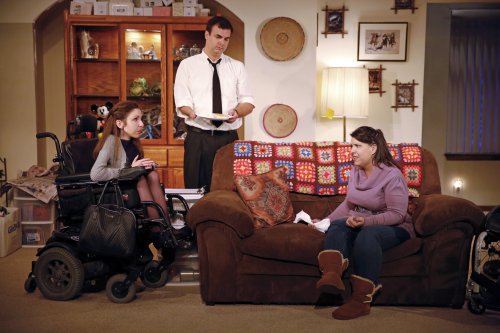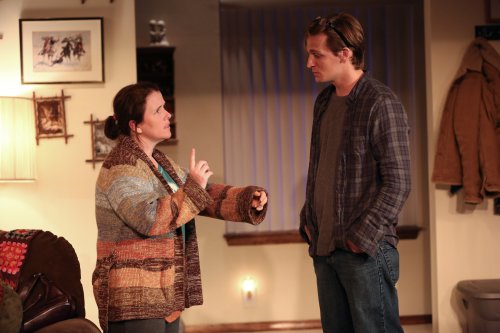The Healing
World premiere play by Samuel D. Hunter for Theater Breaking Through Barriers was written for six actors with disabilities which fulfills the company’s mission.

Shannon DeVido, David Harrell and Jamie Petrone in a scene from Samuel D. Hunter’s “The Healing” (Photo credit: Carol Rosegg)
[avatar user=”Victor Gluck” size=”96″ align=”left” ] Victor Gluck, Editor-in-Chief[/avatar]Samuel D. Hunter’s latest play, The Healing, is a commission by Theater Breaking Through Barriers, dedicated to advancing the work of performers with disabilities. Not surprisingly, the play gives roles to six disabled actors out of the seven characters in the play, and they acquit themselves well. This story of a reunion of childhood friends in their thirties who have gathered for the funeral of one of their members is made very real by the acting of the cast. The problem with the play is that it appears so tentative and low-key that the explosion we keep waiting for never happens. Under the direction of Stella Powell-Jones, the healing of the title is so subtle that the play could be said to be anti-theatrical.
Set in Idaho which has become Hunter country (also depicted in his plays A Bright New Boise, The Whale, The Few and Pocatello), The Healing brings together four friends with disabilities who met at a camp as teenagers. Their parents were under the impression that it was a Christian camp. However, it was a Christian Science camp which is something quite different. Christian Scientists do not believe in medicine or doctors, but only the power of prayer. Unfortunately for these campers, they were told by their counselor Joan that they could pray away their disabilities as though their afflictions were a sin to be expiated. With the help of the others, Sharon got the camp shut down when they were 13. However, the scars are still there and they have all been living with them ever since.
Because of Joan, Zoe, the deceased woman, had become a Christian Scientist as a way of dealing with her mental and physical pain. As a result, she did not seek help for her depression or her physical ailments. After years of finding that prayer did not solve her problems, Zoe has committed suicide. Sharon, Donald, Bonnie and Laura who haven’t seen each other in recent years all feel guilty that they didn’t do more to help Zoe through her problems. And all are united in their hatred of Joan – who Donald had invited to the funeral, possibly hoping for an apology. As they bicker about their differing responses to Zoe’s death, with wheelchair-bound Sharon worried about finding an aide for the time she has to spend helping to pack up the contents of the apartment, in walks Joan to say goodbye one last time. Performed in real time, the play has a ring of truth at the same time that it is too leisurely told to be truly satisfying as theater.
Although we learn little about each character as if they know each other so well they don’t have to reveal a great many details, the performers create three dimensional people – though this may be more credited to their acting ability than the writing. Playing wheelchair-bound Sharon, the most successful of the friends, Shannon DeVido hints at the repressed anger just below the surface. As Donald with only one good arm, David Harrell is a sensitive gay man only now learning to live alone who is concerned about the feelings of others.

Mary Theresa Archbold and John McGinty in a scene from Samuel D. Hunter’s “The Healing” (Photo credit: Carol Rosegg)
Jamie Petrone makes Bonnie who also uses a wheelchair an upbeat person who is dealing with her problems in the best way possible. As her deaf boyfriend of nine months, John McGinty is at the same time supportive and ironic in his delivery, both signed or spoken by him and translated by others. Mary Theresa Archbold’s Laura proves to be a catalyst – both for revealing to Bonnie that Zoe had committed suicide as well as shocking the others by having slept in the bedroom of the dead woman rather than going to a hotel. As Zoe who we meet in three flashbacks, Pamela Sabaugh suggests mental suffering but remains an enigma. When Lynne Lipton’s Joan makes her unexpected visit about ten minutes from the end of the play, this timid, guilt-ridden woman is nothing like we expected. The final scene hints at the healing that has not taken place up until that moment.
The most effective element is the physical production. Jason Simms’ set creates a warm cocoon of a home with its cluttered atmosphere. The sofa which cuts the living room set in half causing the characters in the wheelchairs to negotiate around it becomes a metaphor for the obstacles that these characters have dealt with all of their lives. Special kudos go to prop designer Charles Bowden for choosing the many figurines and animals that Zoe has been buying from the Shopping Channel in order to fill up her empty life. Christopher Metzger’s comfortable, lived-in looking costumes define each of the different characters’ lives and personalities. The lighting design by Alejandro Fajardo is used to telegraph the subtle time changes that make the flashbacks possible.
Samuel D. Hunter’s new play The Healing is a sensitive study of friends living with disabilities and shared unhappy memories. Its weakness is that it is too understated like an example of cinema verité that has not been truly shaped as a piece of drama. Director Stella Powell-Jones has obtained beautiful performances from her cast at the same time that her pacing seems lacking in dynamism. It is to be hoped that Hunter will revise this version for the next production into a more forceful and compelling drama.
The Healing (through July 16, 2016)
Theater Breaking Through Barriers
Clurman Theatre on Theatre Row, 410 W. 42nd Street, in Manhattan
For tickets, call 212-239-6200 or visit http://www.telecharge.com
Running time: 95 minutes without an intermission






Leave a comment